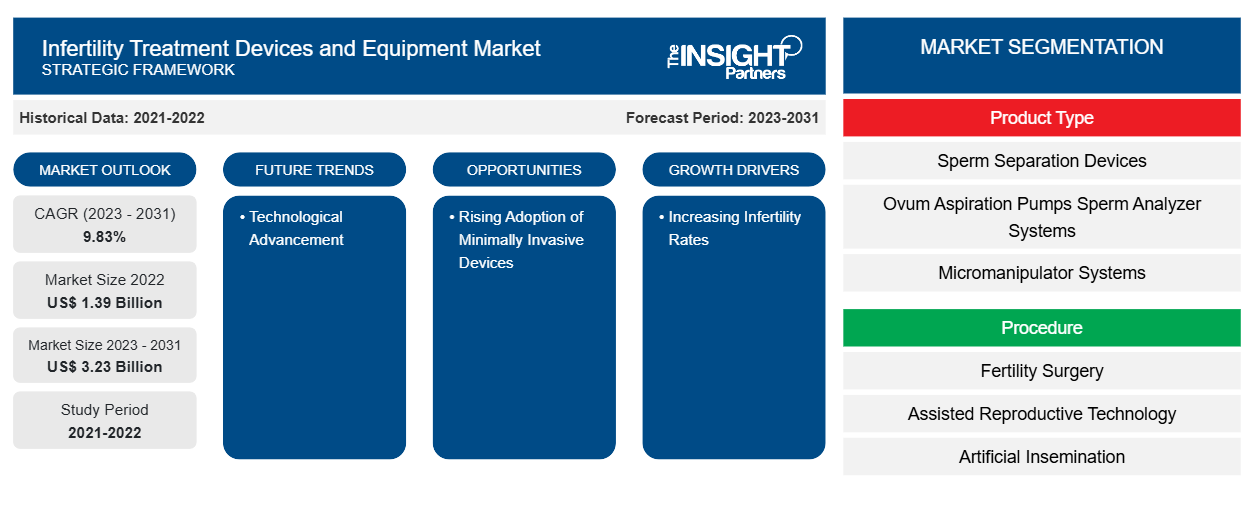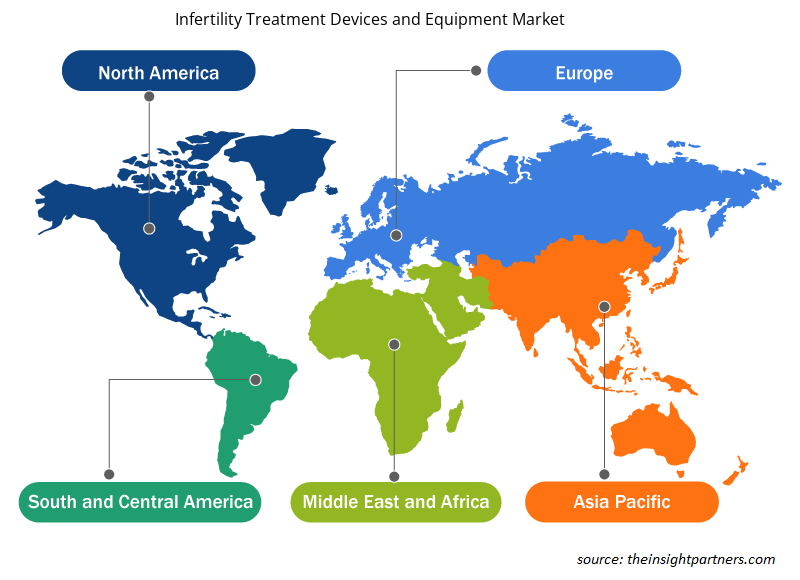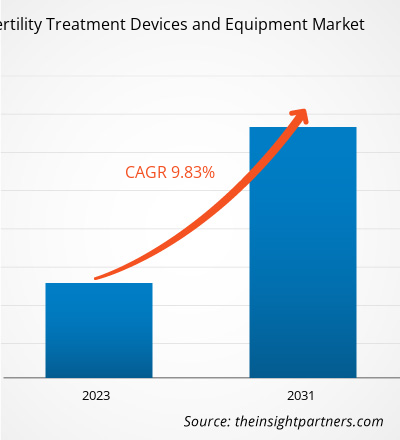Si prevede che la dimensione del mercato dei dispositivi e delle attrezzature per il trattamento dell'infertilità raggiungerà i 3,23 miliardi di dollari entro il 2031, rispetto ai 1,39 miliardi di dollari del 2022. Si prevede che il mercato registrerà un CAGR del 9,83% nel 2023-2031. Lo sviluppo di nuovi trattamenti per l'infertilità, come l'iniezione intracitoplasmatica di sperma, rimarrà probabilmente una tendenza chiave del mercato dei dispositivi e delle attrezzature per il trattamento dell'infertilità.
Analisi di mercato dei dispositivi e delle attrezzature per il trattamento dell'infertilità
L'infertilità è l'incapacità di concepire dopo un anno di rapporti sessuali non protetti. L'Organizzazione Mondiale della Sanità (OMS) l'ha riconosciuta come un problema di salute pubblica. Il mercato globale dei dispositivi e delle attrezzature per il trattamento dell'infertilità sta vivendo una crescita significativa a causa di vari fattori, tra cui il calo del tasso di fertilità globale, il tasso di successo più elevato delle tecnologie riproduttive avanzate e il crescente supporto da parte del governo e di altre organizzazioni sanitarie. Si prevede che questi fattori favoriranno lo sviluppo di nuovi trattamenti per migliorare la fertilità.
Panoramica del mercato dei dispositivi e delle attrezzature per il trattamento dell'infertilità
Come riportato dall'OMS, circa il 17,5% degli adulti in tutto il mondo soffre di infertilità. La prevalenza della condizione nel corso della vita è stata riscontrata essere del 17,8% nei paesi ad alto reddito e del 16,5% nei paesi a basso e medio reddito. L'aumento dei casi di infertilità porta a una crescita del numero di pazienti che cercano trattamenti per l'infertilità. Ciò ha evidenziato la necessità di cure per la fertilità accessibili e di alta qualità, che contribuiscono all'espansione del mercato dei dispositivi e delle attrezzature per il trattamento dell'infertilità.
Personalizza questo report in base alle tue esigenze
Riceverai la personalizzazione gratuita di qualsiasi report, comprese parti di questo report, o analisi a livello nazionale, pacchetto dati Excel, oltre a usufruire di grandi offerte e sconti per start-up e università
Mercato dei dispositivi e delle attrezzature per il trattamento dell'infertilità: approfondimenti strategici

-
Scopri le principali tendenze di mercato in questo rapporto.Questo campione GRATUITO includerà analisi di dati che spaziano dalle tendenze di mercato alle stime e alle previsioni.
Driver di mercato e opportunità per dispositivi e attrezzature per il trattamento dell'infertilità
Elevati tassi di successo delle tecnologie avanzate per il trattamento dell'infertilità favoriscono il mercato
I trattamenti riproduttivi hanno fatto notevoli progressi, ampliando le opzioni e i tassi di successo dei trattamenti per l'infertilità come la tecnologia di riproduzione assistita (ART). Secondo un articolo pubblicato su Cureus nell'ottobre 2022, nei prossimi anni si prevede che la fecondazione in vitro sarà ampiamente utilizzata in più regioni del mondo, portando alla nascita fino al 10% di tutti i bambini e i tassi di successo della maturazione in vitro (IVM) sono aumentati fino al 56% grazie ai progressi tecnologici, al miglioramento degli strumenti necessari e all'esperienza e alla formazione accumulate da coloro che eseguono la procedura. Inoltre, i metodi di consapevolezza della fertilità, come le app di monitoraggio dell'ovulazione , sono diventati più accessibili e affidabili, consentendo decisioni informate sulla pianificazione familiare
Dispositivi minimamente invasivi: un’opportunità nel trattamento dell’infertilità
Diverse anomalie e condizioni, tra cui fibromi uterini, anomalie mülleriane, cisti ovariche ed endometriosi, possono ridurre le possibilità di gravidanza. Questi problemi possono anche causare spiacevoli effetti collaterali, tra cui dolore pelvico cronico e forti emorragie. L'intervento chirurgico può essere il trattamento più efficace per questi sintomi in tali casi. L'adozione di tecniche minimamente invasive come laparoscopia e isteroscopia può affrontare la causa sottostante dell'infertilità con riduzione del dolore, dei tempi di recupero, del rischio di infezione e della perdita di sangue. Le procedure comportano l'uso di piccole incisioni e telecamere ad alta definizione che proiettano l'area dell'operazione su un monitor anziché grandi incisioni aperte utilizzate negli interventi chirurgici convenzionali.
Analisi della segmentazione del mercato dei dispositivi e delle attrezzature per il trattamento dell'infertilità
I segmenti chiave che contribuiscono alla derivazione dell'analisi di mercato dei dispositivi e delle attrezzature per il trattamento dell'infertilità sono il tipo di prodotto, la procedura e l'utente finale.
- In base al tipo di prodotto, il mercato dei dispositivi e delle attrezzature per il trattamento dell'infertilità è suddiviso in dispositivi di separazione dello sperma, pompe di aspirazione degli ovociti, sistemi di analisi dello sperma, sistemi di micromanipolazione, incubatori e altri. Il segmento delle pompe di aspirazione degli ovociti ha detenuto la quota di mercato maggiore nel 2023.
- Per procedura, il mercato è segmentato in tecnologia di riproduzione assistita, chirurgia della fertilità e inseminazione artificiale. Il segmento dell'inseminazione artificiale ha detenuto la quota di mercato più grande nel 2023. Inoltre, si prevede che il segmento della tecnologia di riproduzione assistita registrerà il CAGR più elevato dal 2023 al 2031.
- In termini di utente finale, il mercato è segmentato in cliniche per la fertilità, ospedali e altre strutture sanitarie e istituti di ricerca clinica. Il segmento delle cliniche per la fertilità ha dominato il mercato nel 2023.
Analisi della quota di mercato dei dispositivi e delle attrezzature per il trattamento dell'infertilità per area geografica
L'ambito geografico del rapporto sul mercato dei dispositivi e delle attrezzature per il trattamento dell'infertilità è suddiviso principalmente in cinque regioni: Nord America, Asia Pacifico, Europa, Medio Oriente e Africa, e Sud e Centro America.
Il Nord America ha dominato il mercato dei dispositivi e delle attrezzature per il trattamento dell'infertilità. Secondo il Dipartimento della Salute e dei Servizi Umani degli Stati Uniti, nel 2021, circa il 2,3% dei neonati nati negli Stati Uniti è stato concepito tramite ART, con ~ 413.776 cicli eseguiti in 453 cliniche, risultanti in 112.088 gravidanze. Il numero crescente di procedure AR come la fecondazione in vitro, i crescenti tassi di infertilità tra gli uomini e la presenza di attori del mercato globale sono fattori che contribuiscono al predominio del mercato dei dispositivi e delle attrezzature per il trattamento dell'infertilità del Nord America. Si prevede che l'Asia Pacifica crescerà con il CAGR più elevato nei prossimi anni.
Approfondimenti regionali sul mercato dei dispositivi e delle attrezzature per il trattamento dell'infertilità
Le tendenze regionali e i fattori che influenzano il mercato dei dispositivi e delle attrezzature per il trattamento dell'infertilità durante il periodo di previsione sono stati ampiamente spiegati dagli analisti di Insight Partners. Questa sezione discute anche i segmenti e la geografia del mercato dei dispositivi e delle attrezzature per il trattamento dell'infertilità in Nord America, Europa, Asia Pacifico, Medio Oriente e Africa e America meridionale e centrale.

- Ottieni i dati specifici regionali per il mercato dei dispositivi e delle attrezzature per il trattamento dell'infertilità
Ambito del rapporto di mercato sui dispositivi e le attrezzature per il trattamento dell'infertilità
| Attributo del report | Dettagli |
|---|---|
| Dimensioni del mercato nel 2022 | 1,39 miliardi di dollari USA |
| Dimensioni del mercato entro il 2031 | 3,23 miliardi di dollari USA |
| CAGR globale (2023-2031) | 9,83% |
| Dati storici | 2021-2022 |
| Periodo di previsione | 2023-2031 |
| Segmenti coperti |
Per tipo di prodotto
|
| Regioni e Paesi coperti |
America del Nord
|
| Leader di mercato e profili aziendali chiave |
|
Dispositivi e attrezzature per il trattamento dell'infertilità: densità degli attori del mercato: comprendere il suo impatto sulle dinamiche aziendali
Il mercato dei dispositivi e delle attrezzature per il trattamento dell'infertilità sta crescendo rapidamente, spinto dalla crescente domanda degli utenti finali dovuta a fattori quali l'evoluzione delle preferenze dei consumatori, i progressi tecnologici e una maggiore consapevolezza dei benefici del prodotto. Con l'aumento della domanda, le aziende stanno ampliando le loro offerte, innovando per soddisfare le esigenze dei consumatori e capitalizzando sulle tendenze emergenti, il che alimenta ulteriormente la crescita del mercato.
La densità degli operatori di mercato si riferisce alla distribuzione di aziende o società che operano in un particolare mercato o settore. Indica quanti concorrenti (operatori di mercato) sono presenti in un dato spazio di mercato in relazione alle sue dimensioni o al valore di mercato totale.
Le principali aziende che operano nel mercato dei dispositivi e delle attrezzature per il trattamento dell'infertilità sono:
- Termo Fisher Scientifico
- Gruppo di cucina
- Vitrovita
- Assistenza tecnica IVFtech
- Società anonima Hamilton Thorne Ltd.
- Esco Micro Pte Ltd
Disclaimer : le aziende elencate sopra non sono classificate secondo un ordine particolare.

- Ottieni una panoramica dei principali attori del mercato dei dispositivi e delle attrezzature per il trattamento dell'infertilità
Dispositivi e attrezzature per il trattamento dell'infertilità: notizie di mercato e sviluppi recenti
Il mercato dei dispositivi e delle attrezzature per il trattamento dell'infertilità viene valutato raccogliendo dati qualitativi e quantitativi dopo la ricerca primaria e secondaria, che include importanti pubblicazioni aziendali, dati associativi e database. Di seguito è riportato un elenco degli sviluppi nel mercato dei dispositivi e delle attrezzature per il trattamento dell'infertilità:
- Trajan Scientific and Medical ha fornito dispositivi Mitra registrati CE-IVD a Fertilly, una start-up tedesca. Fertilly ha lanciato i primi kit per test di fertilità a domicilio in Europa utilizzando il microcampionamento di sangue essiccato con tecnologia VAMS. I dispositivi di microcampionamento Mitra consentono una raccolta rapida e semplice di campioni di sangue tramite punture del dito, che possono poi essere inviati a un laboratorio per l'analisi come sangue essiccato. (Fonte: Trajan Scientific Australia Pty Ltd, comunicato stampa, 2023)
- Merck Specialties Pvt ltd, la divisione sanitaria di Merck in India, ha lanciato la Pergoveris Pen per il trattamento avanzato dell'infertilità in India. Questo lancio sottolinea l'obiettivo dell'azienda di soddisfare esigenze mediche insoddisfatte fornendo un'opzione di trattamento combinato migliorata, comoda e pronta all'uso per le donne con grave carenza di ormone follicolo-stimolante (FSH) e ormone luteinizzante (LH). (Fonte: Merck Specialties Pvt ltd, comunicato stampa, 2021)
Copertura e risultati del rapporto di mercato sui dispositivi e le attrezzature per il trattamento dell'infertilità
Il rapporto "Dimensioni e previsioni del mercato dei dispositivi e delle attrezzature per il trattamento dell'infertilità (2021-2031)" fornisce un'analisi dettagliata del mercato che copre le seguenti aree:
- Dimensioni e previsioni del mercato a livello globale, regionale e nazionale per tutti i segmenti di mercato chiave coperti dall'ambito
- Dinamiche di mercato come fattori trainanti, vincoli e opportunità chiave
- Principali tendenze future
- Analisi dettagliata delle cinque forze PEST/Porter e SWOT
- Analisi di mercato globale e regionale che copre le principali tendenze di mercato, i principali attori, le normative e gli sviluppi recenti del mercato
- Analisi del panorama industriale e della concorrenza che copre la concentrazione del mercato, l'analisi della mappa di calore, i principali attori e gli sviluppi recenti
- Profili aziendali dettagliati
- Analisi storica (2 anni), anno base, previsione (7 anni) con CAGR
- Analisi PEST e SWOT
- Valore/volume delle dimensioni del mercato - Globale, Regionale, Nazionale
- Industria e panorama competitivo
- Set di dati Excel
Report recenti
Testimonianze
Motivo dell'acquisto
- Processo decisionale informato
- Comprensione delle dinamiche di mercato
- Analisi competitiva
- Analisi dei clienti
- Previsioni di mercato
- Mitigazione del rischio
- Pianificazione strategica
- Giustificazione degli investimenti
- Identificazione dei mercati emergenti
- Miglioramento delle strategie di marketing
- Aumento dell'efficienza operativa
- Allineamento alle tendenze normative






















 Ottieni un campione gratuito per - Mercato dei dispositivi e delle attrezzature per il trattamento dell'infertilità
Ottieni un campione gratuito per - Mercato dei dispositivi e delle attrezzature per il trattamento dell'infertilità